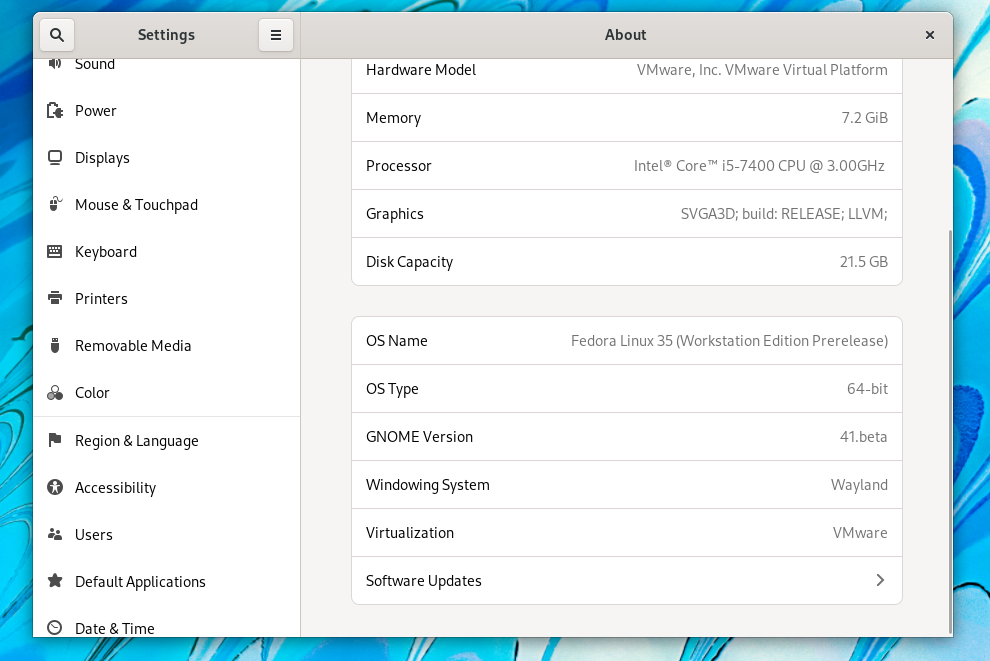
Fedora 35 is just around the corner. And, if you cannot wait already, let us highlight some of the essential details about the release.
Fedora 35 Release Date
The expected release date for Fedora 35 beta is 14th September 2021. But, if delayed, the next planned date is 21st September 2021.
After the public beta testing, the final release has been planned for 19th October 2021, with a delayed date for 26th October 2021.
Of course, you can get your hands on Fedora 35 before the final and beta releases as well. But, considering it is just a few days away from its first beta release, you may want to wait it out.
Fedora 35 Features

Fedora 34 was an exciting release with GNOME 40 and a new i3 spin. And Fedora 35 is also shaping up as an interesting upgrade to it.
Some of the fundamental changes that you can expect are:
GNOME 41
GNOME 41 may not be a radical change when compared to GNOME 40, but there are some visual improvements and valuable feature additions that you can expect.
For instance, the GNOME Software will get a clean look and context tiles, resembling much like all the details that you can find in the Apps for GNOME portal. You should also find VoIP support added to GNOME 41.
A new “Connections” app has been added to let you connect to other platforms/systems remotely.
GNOME 41 has a planned release date of September 22, 2021. So, you may want to watch out for our coverage for the complete details when it releases.
DNS Over TLS Support
DNS Over TLS (DoT) is essential to encrypt DNS requests and prevent your ISP from spying. With Fedora 35, any configured DNS server should automatically attempt to connect using DoT if the DNS supports it.
Default Btrfs Filesystem for Fedora Cloud
While Fedora has already switched to the Btrfs filesystem since Fedora 33, they enforce that change for the Cloud edition.
Linux Kernel 5.14
Linux Kernel 5.14 wasn’t a big release, but it added many features, especially when it comes to ARM devices.
For Fedora 35, the improved hardware support should make a difference.
Flathub Applications Included with Third-Party Repositories
You also get some selected Flatpak applications added from a filtered Flathub remote when you enable third-party repositories.
This should come in handy for better third-party app support in Fedora.
PulseAudio Daemon Replaced by PipeWire
While we saw initial implementations of replacing PulseAudio in Fedora 34, this time, there is a proposal to replace the PulseAudio daemon with a compatible implementation based on PipeWire.
Other Improvements
Along with the key highlights mentioned above, you should find several under-the-hood changes and package updates that could translate as significant upgrades.
For instance, the Firewalld package update and the GNU Toolchain update should prove to be valuable upgrades.
You can explore more about the proposed changes in their official changeset wiki.
Wrapping Up
It should be exciting to see the changes in the final release. For now, let us keep an eye out to test the public beta release. And, if you do not want to experiment on your system with a beta release, you should wait for the stable release.
- Even the biggest players in the Linux world don't care about desktop Linux users. We do.
- We don't put informational content behind paywall. Your support keeps it open for everyone. Think of it like 'pay it forward'.
- Don't like ads? With the Plus membership, you get an ad-free reading experience.
- When millions of AI-generated content is being published daily, you read and learn from real human Linux users.
- It costs just $2 a month, less than the cost of your favorite burger.
Become a Plus Member today and join over 300 people in supporting our work.









